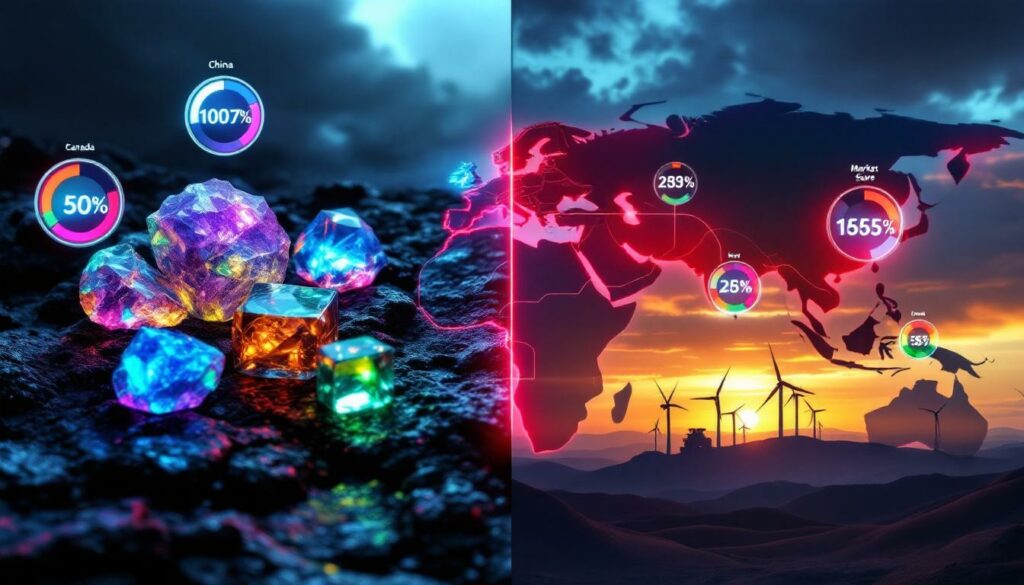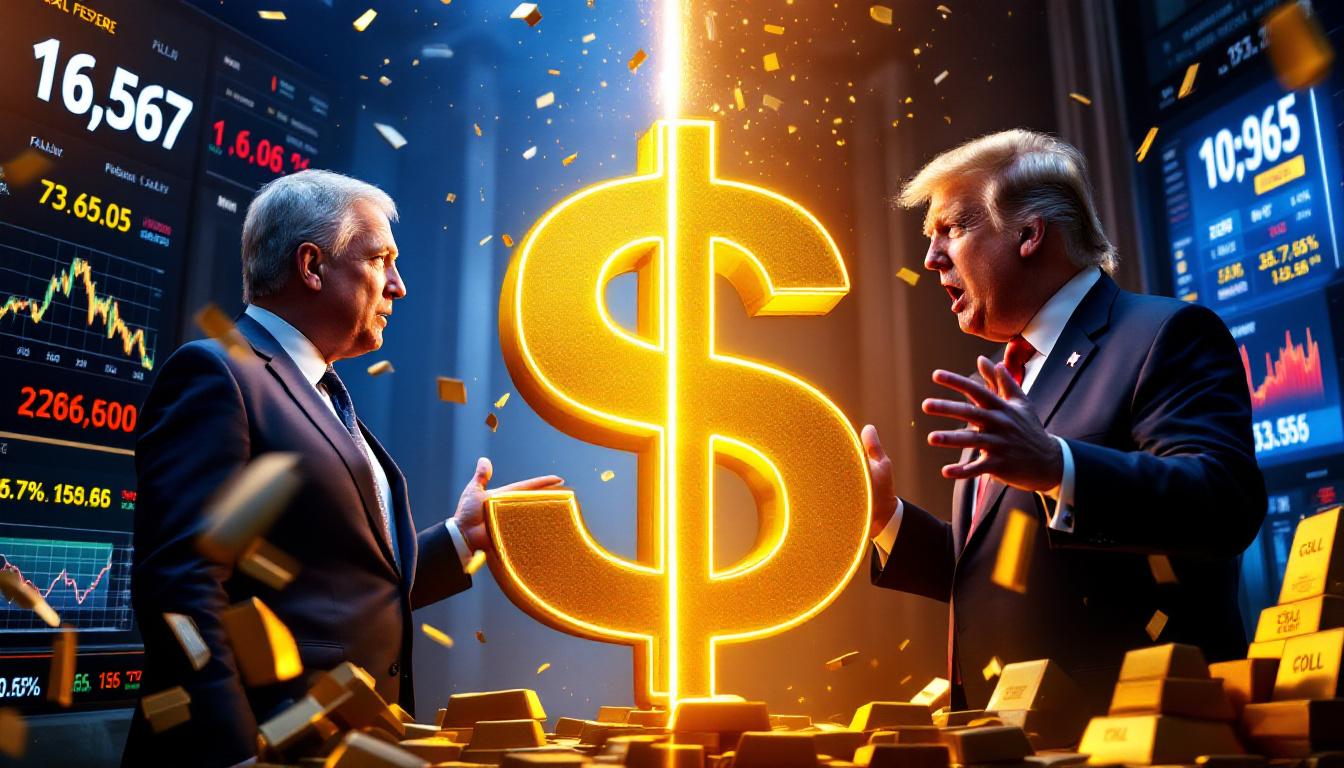What Are Rare Earths and Why Do They Matter?
Rare earth elements (REEs) comprise a group of 17 metallic elements on the periodic table that, despite their name, aren't particularly rare in the Earth's crust. What makes them "rare" is their geochemical properties – they rarely concentrate into economically viable deposits. These elements are divided into two categories: light rare earths (like neodymium and praseodymium) and heavy rare earths (such as dysprosium and terbium), with the latter being significantly scarcer and more valuable.
These minerals have become indispensable in modern technology due to their unique magnetic, luminescent, and electrochemical properties. They're essential components in everything from smartphones and computer hard drives to military guidance systems and medical imaging machines. Perhaps most critically, REEs are fundamental to the green energy transition, with permanent magnets containing neodymium and dysprosium enabling the functionality of electric vehicles and wind turbines.
"The strategic importance of rare earths extends far beyond their industrial applications," notes David Argyle, CEO of REalloys. "They represent a cornerstone of both national security infrastructure and future green technology development."
Understanding Rare Earth Elements and Their Critical Applications
The applications of rare earths span virtually every high-tech industry. Light rare earths like neodymium are crucial for creating powerful permanent magnets used in electric vehicle motors, while heavy rare earths like dysprosium and terbium allow these magnets to maintain performance under extreme temperatures – a necessity for defense applications like precision-guided missiles and radar systems.
In renewable energy, a single large wind turbine can contain up to 600 kg of rare earth materials. Meanwhile, each electric vehicle requires approximately 1-2 kg of rare earth elements for its motor and battery system. As the world pushes toward decarbonization, demand for these elements is projected to increase tenfold by 2030, according to International Energy Agency estimates.
Beyond green technology, rare earths enable:
- Miniaturization of electronics (smartphones, laptops)
- Medical imaging and diagnostic equipment
- Fiber optic communication systems
- Advanced glass polishing and ceramics
- Catalytic converters in vehicles
- Phosphors for energy-efficient lighting
The defense sector relies heavily on these materials for night vision goggles, precision-guided weapons, stealth technology, and satellite communications – making rare earth reserves a matter of national security for many countries.
China's Dominant Position in the Global Rare Earth Supply Chain
China's supremacy in the rare earth market didn't happen by accident. Through decades of strategic investment and environmental policy that accepted higher pollution levels than Western nations would permit, China has established an unparalleled position in the global supply chain.
As of 2024, China accounts for 69% of global rare earth ore production – a dominant but not monopolistic share. However, where China truly controls the market is in processing and refining, with approximately 90% of downstream processing capacity worldwide. Even more concerning for Western nations is China's near-complete monopoly (98-99%) on heavy rare earths used in high-performance magnets essential for defense applications and green technology.
"China has done a remarkable job at putting these supply chains for critical metals together," acknowledges David Argyle. "Once you control these supply chains, it is very difficult for new entrants to displace them because it is a zero-sum game."
This concentration of power gives China significant leverage in trade negotiations and geopolitical disputes. When nations rely on a single source for materials critical to their economic and military security, they become vulnerable to supply disruptions – whether caused by market forces or deliberate policy decisions.
How Did China's Recent Export Halt Impact Global Markets?
China's decision to restrict rare earth exports sent immediate shockwaves through global supply chains, particularly in high-tech manufacturing sectors. The move represented not just a business disruption but a stark reminder of the geopolitical vulnerability created by concentrated supply chains for strategic materials.
"China has a very strong card to play," notes David Argyle, CEO of REalloys. "But they have overplayed it this time because the recent supply halt resulted in minor shutdowns at automotive plants in the US and Europe."
These disruptions, while described as "minor," nonetheless revealed the precarious position of manufacturers reliant on just-in-time delivery systems with minimal inventory buffers. When critical components like rare earth magnets become unavailable, entire production lines can grind to a halt within weeks.
Immediate Effects on Manufacturing and Supply Chains
The most visible impacts occurred in the automotive sector, where assembly lines in Germany and Ohio temporarily paused electric vehicle production due to magnet shortages. These interruptions rippled through supply chains, affecting component suppliers and creating delivery delays for customers.
Price volatility became another immediate consequence, with spot market prices for certain rare earth oxides fluctuating dramatically:
- Terbium oxide prices surged 35% within two weeks of the announcement
- Dysprosium oxide saw a 28% price increase
- Neodymium oxide prices climbed 22%
These price spikes triggered protective behaviors across industries:
- Strategic stockpiling by manufacturers and governments seeking to insulate themselves from future disruptions
- Rush purchases from alternative suppliers in Australia, Malaysia and the United States
- Contract renegotiations as buyers sought to secure stable supply agreements
- Accelerated exploration of substitute materials and recycling initiatives
While many manufacturers had established contingency plans following similar restrictions in 2010, the scale and suddenness of this export halt tested even the most robust risk management strategies.
Strategic Implications for International Trade Relations
China's rare earth export restrictions represent a calculated move within broader trade negotiations. By demonstrating control over materials critical to high-tech manufacturing and defense applications, China gains leverage in discussions ranging from tariff structures to technology transfer policies.
The restrictions appear strategically timed to coincide with ongoing trade tensions, serving as a reminder of supply chain vulnerabilities when countries consider imposing tariffs or export controls on Chinese goods. Historical precedent shows China has used rare earth availability as a bargaining chip during previous diplomatic disputes.
Unlike the 2010 restrictions that triggered a World Trade Organization case, the current measures have been implemented through more subtle mechanisms – production quotas, environmental inspections, and licensing requirements – making them more difficult to challenge through international trade mechanisms.
The US–China trade impact has been measured but determined, with affected nations accelerating efforts to develop alternative supply chains while avoiding rhetoric that might escalate tensions. This calculated approach suggests a recognition that immediate confrontation would be counterproductive, while long-term supply diversification remains the strategic priority.
What Challenges Face Non-Chinese Rare Earth Development?
Establishing rare earth supply chains outside China faces formidable obstacles that extend far beyond simply finding mineral deposits. The journey from discovery to production involves complex technical processes, significant environmental considerations, and financial hurdles that have deterred all but the most determined investors.
"China's advantage goes beyond just having the resources," explains David Argyle. "They've developed proprietary technologies and expertise over decades that create significant barriers to entry for new competitors."
These barriers help explain why, despite widespread recognition of supply chain vulnerabilities, progress in developing alternative sources has been painstakingly slow.
Technical Barriers to Building Alternative Supply Chains
The technical complexity of rare earth processing represents perhaps the most significant obstacle to supply chain diversification. Unlike many minerals that can be separated through relatively straightforward physical processes, rare earth elements require sophisticated chemical separation techniques due to their similar properties.
The processing journey involves multiple challenging stages:
- Mining and concentration: Extracting and concentrating rare earth-bearing minerals from host rock
- Cracking: Using acid or alkaline solutions to break down mineral structures
- Leaching: Dissolving rare earth content into solution
- Solvent extraction: Using chemical solvents to separate individual elements (requiring hundreds of mixing and settling stages)
- Precipitation: Converting solutions to solid compounds
- Reduction: Converting oxides to metals
- Alloying and manufacturing: Creating magnets or other end products
Each step requires specialized equipment, precise chemical control, and experienced operators. The separation of heavy rare earths, in particular, presents extraordinary technical challenges due to their nearly identical chemical properties, requiring hundreds of sequential extraction stages.
Environmental considerations further complicate development, as processing typically generates significant:
- Acidic or alkaline waste streams requiring neutralization
- Radioactive byproducts from thorium and uranium present in many rare earth ores
- Greenhouse gas emissions from energy-intensive processes
- Large volumes of waste rock and tailings requiring management
Outside China, these environmental challenges face stricter regulatory scrutiny, requiring more costly mitigation measures that impact project economics.
Financial Hurdles for New Market Entrants
The financial obstacles facing new rare earth ventures are equally daunting. REalloys' investment of over US$50 million for a relatively modest production line yielding just 1,000 tonnes of magnet materials by 2027 illustrates the capital-intensive nature of the industry.
Developing a complete mine-to-magnet supply chain typically requires:
- $500 million to $1 billion for mine development
- $200-400 million for separation facilities
- $100-200 million for metal production
- $50-150 million for alloy and magnet manufacturing
These substantial investments face extended payback periods, with most projects requiring 7-10 years to achieve positive cash flow. This timeline exceeds the investment horizon of many conventional funding sources, creating a financing gap that often requires government support to bridge.
The economics are further challenged by:
"China's established position allows them to temporarily lower prices whenever new competition emerges, making it extremely difficult for new entrants to gain a foothold in the market." – Industry analyst quoted in a recent mining journal
The combination of high capital requirements, technical complexity, and market uncertainty creates a formidable barrier to establishing competitive rare earth supply chains outside China. Without significant changes to market dynamics or policy interventions, these challenges will continue to slow diversification efforts.
Are Government Interventions Necessary for Supply Chain Resilience?
The formidable barriers to developing rare earth supply chains outside China raise a fundamental question: Can market forces alone drive diversification, or are government interventions essential? Industry experts increasingly conclude that some form of policy support is necessary to establish resilient supply chains for these strategically important materials.
"The economics simply don't work without some form of government intervention," notes David Argyle of REalloys. "Between the capital intensity, technical challenges, and China's pricing advantages, new entrants face nearly insurmountable obstacles without policy support."
This recognition has sparked debate about the most effective forms of government intervention, with subsidies and tariffs in response to China's rare earth export curbs emerging as the primary policy tools under consideration.
The Case for Subsidies to Support Domestic Production
Direct financial support through subsidies offers several advantages for stimulating rare earth supply chain development. These mechanisms can target specific bottlenecks in the value chain and provide the certainty needed for long-term investments.
Effective subsidy approaches might include:
- Production credits that provide per-kilogram payments for domestically produced rare earth materials
- Capital grants offsetting the initial investment costs for processing facilities
- Research funding to develop more cost-effective processing technologies
- Loan guarantees reducing financing costs for capital-intensive projects
- Tax incentives improving project economics through deductions or credits
The economic justification for such support extends beyond conventional market failure arguments to encompass national security considerations and strategic industrial policy. When materials are critical to both defense applications and emerging clean energy technologies, governments have compelling reasons to ensure domestic availability.
Different regions have implemented varied approaches:
| Region | Subsidy Approach | Key Features |
|---|---|---|
| United States | Defense Production Act funding + IRA tax credits | Focuses on defense supply chains with some commercial support |
| European Union | Critical raw materials facility | €10 billion program combining grants, loans, and investment incentives |
| Japan | Strategic resource fund | Government co-investment with private sector in projects globally |
| Australia | Producer tax credits | 30% credit for domestic production of critical minerals |
Evidence from other critical mineral sectors suggests subsidies can effectively stimulate production. For instance, government support for semiconductor manufacturing has successfully established new production capacity, though at substantial public cost.
Evaluating Tariff Strategies to Level the Playing Field
While subsidies address the supply side of the equation, tariffs focus on market access, potentially creating space for domestic producers to develop by limiting foreign competition. Tariffs on Chinese rare earth products could help level the playing field by offsetting advantages gained through years of state support and less stringent environmental standards.
Potential tariff approaches include:
- Graduated tariff structures that impose higher rates on processed materials than raw materials, encouraging domestic value addition
- Targeted tariffs on specific products where supply chain vulnerabilities are most acute
- Conditional tariffs that reduce rates as domestic capacity develops
- Coordinated multi-nation tariffs that prevent circumvention through third countries
However, tariffs present significant complications:
- Potential for retaliatory measures affecting other industries
- Higher costs for downstream manufacturers using rare earth products
- World Trade Organization compliance challenges
- Difficulties in enforcement due to complex supply chains
The tariff debate highlights the tension between free market principles and national security considerations. While economists often argue against trade barriers, strategic industries sometimes warrant exceptions when critical supply chains face concentrated foreign control.
"Finding the right balance between market-based solutions and government intervention is critical. Too little support fails to address market failures, while excessive intervention risks creating inefficient industries dependent on permanent subsidies." – Economic policy expert
Both subsidies and tariffs represent imperfect solutions with significant tradeoffs. The optimal approach likely involves a calibrated combination of temporary supports designed to overcome initial barriers while establishing a path to commercial sustainability.
What Alternative Supply Chain Models Are Emerging?
As governments and companies recognize the strategic vulnerability created by China's rare earth dominance, innovative supply chain models are emerging to address these challenges. These approaches move beyond simple reshoring to embrace international collaboration, diversified sourcing, and circular economy principles.
"We're seeing a fundamental rethinking of how critical mineral supply chains should function," observes David Argyle of REalloys. "The old model of each country trying to develop completely independent capabilities is giving way to more collaborative approaches that leverage comparative advantages."
These new models aim to balance resilience with economic viability, recognizing that complete self-sufficiency may be neither practical nor cost-effective for most nations.
International Collaboration Initiatives
Cross-border partnerships have emerged as a pragmatic response to the technical and financial challenges of rare earth development. By sharing resources, expertise, and markets, these collaborative ventures can achieve scale economies while distributing risk across multiple stakeholders.
REalloys' partnership with the Saskatchewan Research Council exemplifies this approach. As detailed in the SCMP report, this collaboration combines REalloys' processing expertise with the Council's research capabilities and access to Canadian resources. Similar partnerships are developing globally:
- The Japan-Australia Critical Minerals Partnership, combining Japanese financing and technical expertise with Australian mining resources
- The European Raw Materials Alliance, coordinating investments across EU member states
- The U.S.-Canada Critical Minerals Working Group, harmonizing policies and development priorities
These initiatives often include:
- Joint research programs to advance processing technologies
- Shared infrastructure investments reducing capital requirements for individual companies
- Long-term offtake agreements providing market certainty for producers
- Standardized regulatory frameworks simplifying compliance across jurisdictions
- Coordinated diplomatic approaches to resource-rich countries
Such collaborations recognize that while no single non-Chinese country can match China's complete rare earth ecosystem, coordinated efforts across multiple nations can create viable alternatives for critical segments of the supply chain.
Diversification of Rare Earth Sourcing Strategies
Beyond geographical diversification, companies and governments are pursuing multi-faceted approaches to secure rare earth supplies. These strategies acknowledge that primary mining alone cannot meet growing demand or provide sufficient resilience.
REalloys exemplifies this diversified approach by:
- Developing a mine in Saskatchewan for primary production
- Sourcing ore from Brazil to access different geological deposits
- Incorporating recycled materials to reduce primary resource requirements
This diversification strategy is being adopted more broadly, with several complementary approaches gaining traction:
Emerging mining operations are advancing in multiple jurisdictions:
- Brazil's Serra Verde project targeting ionic clay deposits similar to China's southern provinces
- Australia's Iluka Resources developing integrated mining and processing
- Greenland's Kvanefjeld project containing significant heavy rare earth resources
- Various African nations exploring deposits with international development partners
Recycling and urban mining offer increasingly viable supplementary sources:
- End-of-life magnets from motors and electronic devices contain concentrated rare earth content
- Advanced hydrometallurgical processes can recover up to 95% of rare earth content
- Industrial waste streams from metal production and catalytic converters provide additional sources
- "Product as service" business models are emerging to ensure return of rare earth-containing components
Technological innovations are reducing rare earth dependencies:
- Magnet manufacturers developing designs that use less dysprosium while maintaining performance
- Alternative motor technologies reducing or eliminating rare earth requirements
- Molecular design approaches creating substitute materials with similar properties
The most resilient supply chains will likely incorporate elements from each of these approaches, balancing the security of diverse primary sources with the sustainability advantages of circular economy models. Furthermore, the development of an Australian strategic reserve represents another important component in the global response to supply chain vulnerabilities.
How Might the Rare Earth Market Evolve by 2030?
Predicting the future of rare earth markets requires balancing technical realities with geopolitical and economic factors. While
Seeking the Next Major Mineral Discovery?
Discover why strategic investments in ASX mineral discoveries can lead to substantial returns by exploring Discovery Alert's dedicated discoveries page, where the proprietary Discovery IQ model transforms complex geological data into actionable investment insights. Begin your 30-day free trial today at https://discoveryalert.com.au/discoveries/ to position yourself ahead of the market.




